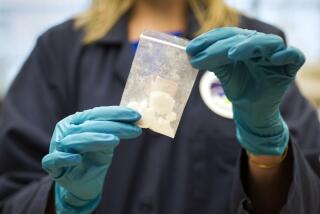Heparin look-alike suspected
- Share via
WASHINGTON — A recalled blood thinner made with active ingredients from China appears to have been contaminated by a mysterious look-alike substance, now the focus of an investigation into as many as 19 U.S. deaths and nearly 800 serious drug reactions, federal officials said Wednesday.
The drug -- heparin -- is a generic medication given to prevent blood clots. The manufacturer, Illinois-based Baxter Healthcare Corp., issued recalls last month after it noticed an unusual increase in reports of severe side effects.
The Food and Drug Administration’s findings raised questions about whether the medication was deliberately contaminated or whether some problem occurred in processing, either in China or in the United States.
FDA officials said the as-yet unidentified contaminant was detected only through sophisticated testing not generally done by manufacturers or their suppliers. In the kinds of routine tests required before the drug was shipped, the contaminant apparently behaved much like heparin, and its presence went unnoticed.
“This substance . . . appears to act like heparin,” said FDA Deputy Commissioner Janet Woodcock, calling the case “a classic chemical investigation.”
A case of deliberate contamination would echo last year’s massive pet food recall, prompted by a chemical that a supplier in China mixed with food to boost the product’s performance in nutritional testing.
FDA officials cautioned that the investigation was at an early stage and that they were still seeking answers to many basic questions. Indeed, investigators have yet to establish whether the suspect ingredient actually caused the severe reactions -- including life-threatening drops in blood pressure -- seen in some patients.
“There is an association between the contaminant and the presence of adverse events, but it is not a direct causal link yet,” Woodcock said.
The agency has come under fire from Congress because it failed to inspect the Chinese facility that produced the heparin, Changzhou SPL, before allowing it to ship the drug to the United States. Someone at the FDA mixed up the name of the plant with that of another facility that had been inspected. A belated FDA inspection last month found a series of problems with documentation, equipment and waste disposal at the Changzhou plant.
Baxter said in a statement that it, too, is focusing on possible problems with the active ingredient. “The root cause may be associated with the crude heparin, sourced from China, or from the subsequent processing of that product before it reaches Baxter,” the company said.
But Baxter’s supplier, Scientific Protein Laboratories, said it was “premature” to single out the active ingredient supplied from China. Wisconsin-based Scientific Protein Laboratories and a Chinese company are joint-venture partners in the Changhzou plant.
“FDA speculated that the source of the adverse events may be a contaminant,” the Wisconsin company’s statement said. “It is important to note that this theory is speculation at this point.”
The company, a well-established supplier of heparin, said it is fully cooperating with the FDA investigation.
Heparin is derived from a substance found in the lining of pigs’ intestines. China dominates the world market because of its low labor costs and an abundant supply of pigs.
The Changzhou SPL plant gets its raw materials from middlemen known as consolidators, who deal with slaughterhouses that receive pigs from farms. China has recently instituted tighter veterinary controls, but it’s unclear how far back U.S. investigators will be able to trace the sources of the heparin. Baxter said it relies on SPL to maintain the integrity of its supply chain.
Baxter said it started noticing an increase in reports of problems in late December. Initially, these reports came from dialysis centers; later, problems started to surface at hospitals. The company launched an internal investigation Jan. 4 and notified the FDA a week later.
Baxter officials said they were at first unsure of the scope of the problems and contacted the FDA as soon as they learned that patients in hospitals, and not just those in dialysis centers, were affected. Heparin, a powerful drug, can cause serious reactions even under normal circumstances.
But the company and the FDA disagree on the extent of the potential damage caused by the recalled heparin. Baxter says it has received about 450 reports of drug reactions and is investigating four deaths, none of which has been conclusively tied to its product.
The FDA says it has received 785 reports of serious reactions, including 19 deaths. Baxter is focusing on reports received since Dec. 15; the FDA is looking at all of 2007.
The FDA’s Woodcock said the contaminant was detected at fairly high levels -- ranging from 5% to 20% -- in some of the samples tested by the agency. It appears to be a molecular cousin of heparin, although it has yet to be identified.
“We do not know whether it inadvertently got into the supply or was added,” she said.
--
ricardo.alonso-zaldivar@latimes.com
More to Read
Sign up for Essential California
The most important California stories and recommendations in your inbox every morning.
You may occasionally receive promotional content from the Los Angeles Times.









